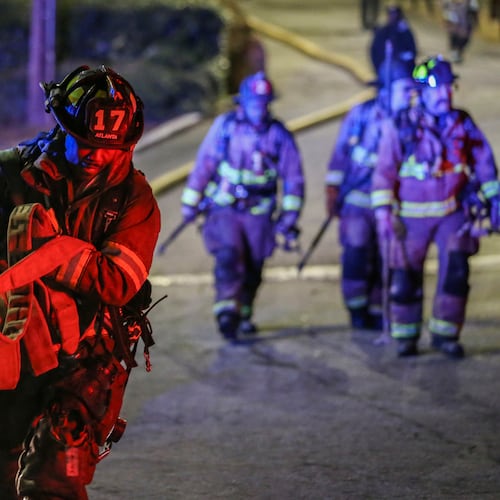1010 Midtown, a swank new condo high-rise on Peachtree Street, is already using its walking-distance proximity to the Atlanta Symphony Orchestra's proposed concert hall at Peachtree and 15th Street as a selling point on its Web site.
Small problem with that: The Woodruff's board of trustees hasn't even voted yet on the switch of construction sites, from 14th Street, off Peachtree, to a corner of the art center's campus. The original site is where a drive to build a $300 million "postcard" for Atlanta, designed by Spanish architect Santiago Calatrava, stalled out two years ago.
Bigger issue: Some of the original donors remain to be persuaded, more are needed, and prospects of public funding, particularly in a troubled economy, would appear iffy at best.
The Woodruff is far from a point where it can say how much money will be needed to finally give the ASO a home worthy of its growing ambitions — a new architectural plan will have to be created first, either by Calatrava or another architect.
"It is too early to talk about a funding plan or timetable for implementation," Woodruff vice president Virginia Vann said.
But whatever the figure ends up being, a new strategy is called for, says Atlanta fund-raising consultant G. Douglass Alexander.
"It's very difficult to have a successful, large campaign, over $100 million, without big gifts to floor the campaign early," says Alexander, who helped run the High Museum of Art's $130 million expansion drive. "The Woodruff gets a $1 million pledge, and now they've got $299 million to go — whoopie! You've got to have people thinking this is going to happen so they'll give the most they can give, not the least."
The Woodruff raised barely more than a third of the funds needed to build on the 14th Street site, in which the hall would have been encircled by high-rises, one impeding the view from Peachtree. The site's unpopularity with some potential donors is one reason why the drive appears ready for a reboot after a long decade of work.
Just how much money is needed to build on the Woodruff campus is unknown. A safe guess is that it will be less than the $300 million required to build Calatrava's design, which included hydraulic "wings" that would open over atrium windows on concert nights, but more than Nashville's comparatively plain Schermerhorn Symphony Center, completed for $123.5 million.
Alexander believes the Woodruff's chances of success the second time around hinge on scoring a gift of at least 20 percent of the goal before going out of the gate. "If they can get a gift of $75 million to $100 million, they can do it," he says. "If not, it's going to be a struggle."
The president of the Arthur M. Blank Family Foundation, which made the original drive's largest pledge, $35 million, characterized its position on the new site as "wait-and-see." On the edge of the Woodruff campus, the 2,000-seat hall would replace a modest-sized car drop-off area, require the demolition of part of the front edge of the arts center and annex part of its expansive basement.
"Now we all need to work together to ensure that the hall's architectural design does justice to a world-class orchestra," foundation president Penny McPhee said.
The leader of the Atlanta-based Zeist Foundation, which committed to the third-largest gift, $7 million, is less reserved in her backing.
"We are incredibly supportive of the Symphony and Woodruff Arts Center and all the time they've taken on the 25-year master plan," which calls for the new hall to neighbor the Alliance Theatre and the nearby High Museum of Art, said Zeist executive director Kappy deButts. "There may not be 'wings' [ultimately], but being on the Woodruff campus is very important."
Coca-Cola, which pledged $10 million, said in a statement only that it is broadly supportive of "plans to build a new facility."
Several other previously committed funders, including SunTrust and UPS, gave variations of the reserving-judgment statement, from the Wachovia Foundation, which pledged $5 million. "Wachovia has not yet seen the details of the master plan, so we are unable to comment," spokeswoman Jamie Grady said.
But securing public funding may well be a bigger challenge than finding or retaining private support. The Woodruff said originally that it needed a third of its campaign, or $100 million, to come from the city and state. But a commitment from Mayor Shirley Franklin or Georgia Gov. Sonny Perdue never materialized.
A representative of the governor could not be reached for comment about funding prospects for the new site.
And, with the city struggling to borrow millions for infrastructure issues such as its water and sewer overhaul, a significant contribution for a concert hall may not be deemed essential.
"Mayor Franklin stayed out of the discussion earlier, so it's not probably appropriate for her to comment now," was all City Hall spokeswoman Catherine H. Woodling would say.
Woodruff CEO Joe Bankoff has said his focus right now is not on funding but passage of the master plan, developed by Boston-based Sasaki Associates, details of which have not been made public. The 79-member Woodruff board had its biannual meeting May 13, but the lack of a quorum prevented a vote. The Woodruff is quietly proceeding on an alternative voting process for the master plan, already OK'd by the Woodruff's executive committee and ASO's board.
The master plan's passage, Vann said, will position the Woodruff "to move when economic conditions improve and the time is right."
About the Author
The Latest
Featured
